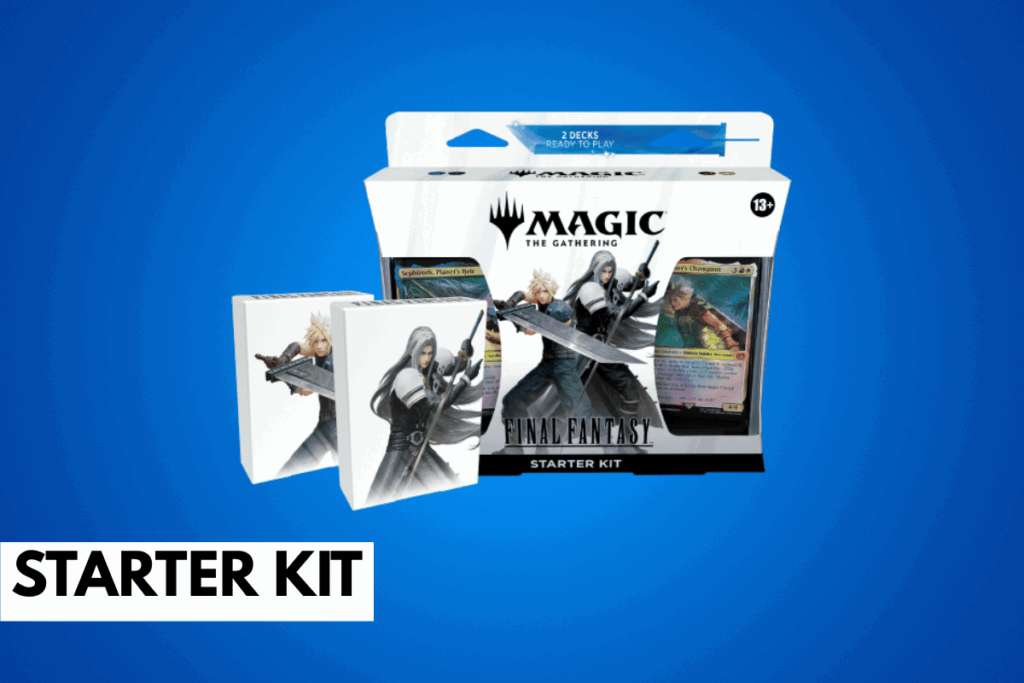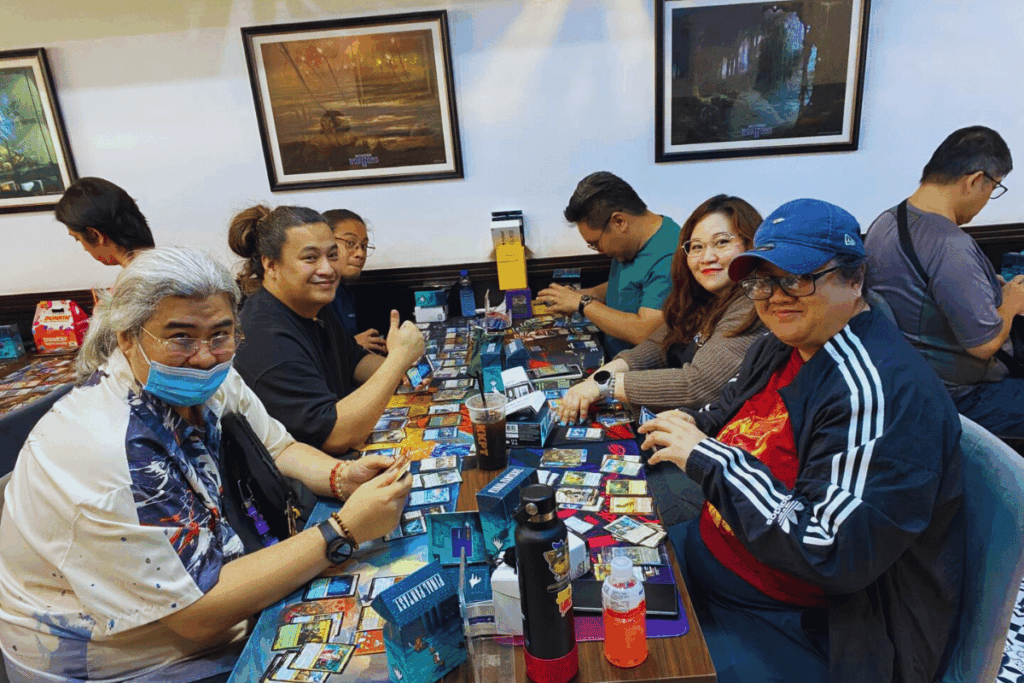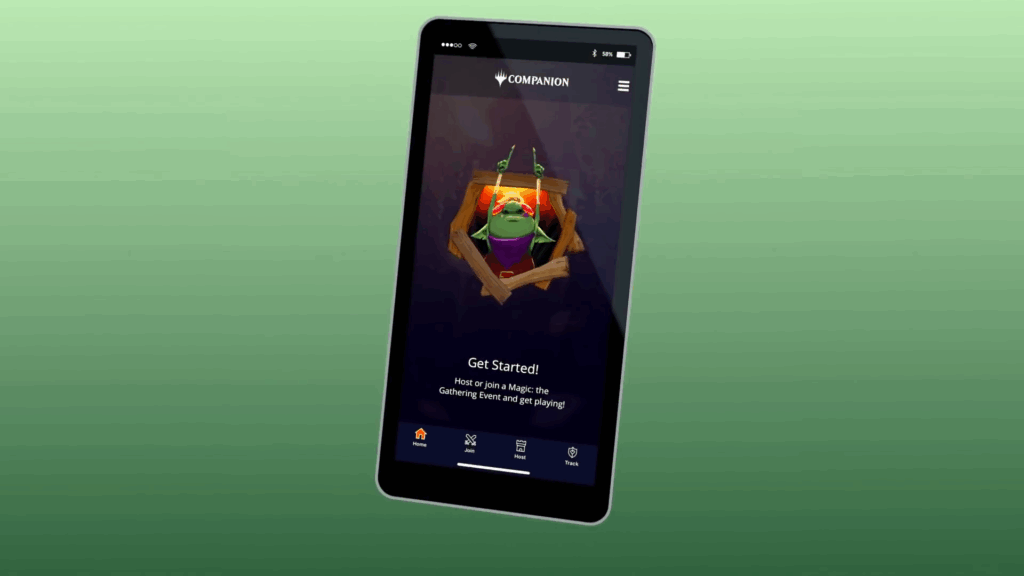If the recent MTG x Final Fantasy prerelease weekend got you curious, you’re not alone—and this might be the perfect time to finally get into Magic: The Gathering.
For a lot of longtime Final Fantasy fans, this past weekend may have been their first real brush with Magic: The Gathering. Whether you saw the cards being posted online, heard friends talking about their pulls, or were simply drawn in by the amazing new art of Cloud, Sephiroth, and other familiar faces, this collaboration has done more than just pay tribute—it’s opened a door. If you’ve never played a trading card game before, it’s totally normal to feel a bit overwhelmed. But here’s the good news: Magic is one of the most welcoming hobbies out there, and right now is one of the best times to start exploring it.
Let’s walk through what you need to know as someone completely new, especially if you’re coming in from the Final Fantasy fandom.
MTG x Final Fantasy – The Best Place to Start: Cloud vs. Sephiroth Starter Kit
If you’re looking to learn the game from scratch, the most beginner-friendly way to dive in is with the Cloud vs. Sephiroth Starter Kit. This product was made with new players in mind and gives you everything you need to begin. Inside the box are two complete 60-card decks—one based around Cloud and the other centered on Sephiroth. These decks are balanced against each other, so you can start playing right away with a friend. The kit also includes a physical rulebook and a guided play insert, helping you ease into the rules without needing to search for tutorials online.

There’s no need to worry about building your own deck or understanding complex card interactions just yet. The Starter Kit is designed to teach you the ropes through actual gameplay, and its familiar characters make it that much more enjoyable to learn. If you’re wondering where to buy it, most local game stores and hobby shops that hosted the prerelease weekend will likely still have some in stock. These stores are also great places to ask questions, meet other players, and discover community events.
MTG x Final Fantasy – Understanding How Magic Cards Are Sold: It’s Kind of Like Gacha
Magic cards are primarily distributed through randomized booster packs. When you buy a pack, you’re essentially opening a sealed set of fifteen cards that can contain a mix of common, uncommon, rare, or mythic rare cards. If that sounds a bit like pulling in a gacha game or opening loot boxes in a video game, you’re absolutely right—it taps into the same sense of excitement and unpredictability.
That means when you’re chasing a specific card, you might not get it right away unless you trade for it or buy it as a single. At the same time, you might end up pulling something unexpectedly powerful or valuable. There’s a lot of variance involved, and it’s important to understand that buying packs is more about discovery than efficiency. If you’re someone who enjoys cracking open random chances and seeing what you get—this part of the hobby will probably feel familiar.
MTG x Final Fantasy – The Next Step: Discovering Commander, Magic’s Most Popular Format
Once you’ve gotten a feel for the game and want to explore more, the most widely played and loved format in Magic is called Commander. Unlike the Starter Kit’s 60-card decks, Commander decks are made up of 100 unique cards—no duplicates except for basic lands—and are built around a legendary creature called your Commander. This creature defines your deck’s color identity and usually serves as the central piece of your strategy.

Commander is typically played in groups of four, making it a fun and chaotic multiplayer experience where alliances, betrayals, and huge board swings happen often. It’s considered one of the most social and casual formats in Magic, perfect for players who love interaction and storytelling in their games. The good news is that there are preconstructed Commander decks available specifically for beginners, known as Commander Starter Decks. These are plug-and-play, much like the Cloud vs. Sephiroth kit, and offer a straightforward way to start learning the deeper aspects of the game.
MTG x Final Fantasy – Prefer 1v1 Duels? There Are Other Formats for That
If multiplayer games aren’t your style and you prefer strategic one-on-one matchups, there are other formats that might appeal to you more. One of the most accessible is Standard, which is played using the most recent sets released within the past couple of years. It’s a rotating format, meaning older sets eventually cycle out to keep the competitive landscape fresh and manageable. Standard is usually the focus at most local events, so if you’re planning on playing regularly at your local store, this is a format worth exploring.
Another format that has been gaining popularity—especially among budget-conscious players—is Pauper. In Pauper, only cards that have been printed at common rarity are allowed, which makes building a deck significantly cheaper without sacrificing depth or competitiveness. Despite its low cost, Pauper decks can still be very powerful and are often favored by players who enjoy efficient, tightly-built strategies. Many local stores support Pauper as a format for casual and competitive events alike, making it a great option for anyone looking to get more serious without spending too much.
Then there’s Modern, a non-rotating format that allows you to use cards from a much larger pool, dating back as far as 2003. While the format can be expensive to enter due to the cost of staple cards, it’s beloved by players who enjoy high-level strategy and finely tuned deckbuilding. It’s not usually recommended for absolute beginners, but once you’ve gotten more comfortable with the game, it’s an exciting long-term destination for competitive-minded players.
MTG x Final Fantasy – A Quick Word on Card Rotation
Since some formats like Standard operate on a rotation system, it’s important to understand that not every card you buy will remain legal in those formats forever. Magic rotates out older sets every year to keep Standard fresh and balanced. So if you’re planning to play competitively in Standard events, you’ll want to keep an eye on which sets are currently legal and when the next rotation is scheduled.
Other formats like Commander, Pauper, and Modern do not have rotation, meaning the cards you collect for those formats remain usable indefinitely, unless they are specifically banned for balance reasons. If your goal is to build a long-term deck without worrying about legality changes, non-rotating formats might be a better fit for you.
MTG x Final Fantasy – Your Local Community and What FNM Means
Once you’re ready to try playing with others, you’ll want to check out something called Friday Night Magic, or FNM. This is a weekly gathering at most local game stores where players come together to play in casual or semi-competitive events. The vibe depends on the shop, but in general, FNM is known for being beginner-friendly and community-driven. You’ll find a mix of players—from seasoned veterans helping newcomers, to casual fans just looking to jam a few games after work.

FNM is a great way to get comfortable playing with strangers, ask questions, win promo cards, and slowly become part of the local scene. You don’t have to be a pro, and no one expects you to bring a tournament-winning deck. Just show up with whatever you have, and you’ll likely find someone happy to help you learn and enjoy the game.
MTG x Final Fantasy – Don’t Forget the Magic Companion App
Before heading to your first event, it’s a good idea to download the Magic: The Gathering Companion App, which is available on both iOS and Android. This app is essential for participating in official events like FNM or prereleases, as it allows you to register, get pairings, and even track your match results. It also helps you find nearby stores hosting events and gives you a convenient way to manage your player profile.

Think of it as your Magic passport—it keeps you connected to the organized side of the hobby and is a great tool for staying in the loop about what’s happening in your area.
It Can Be a Lot—But That’s the Fun Part
There’s no sugarcoating it—Magic can feel overwhelming when you first get into it. There are tons of rules, formats, products, and cards to learn. But the truth is, that variety is exactly what makes the hobby so rewarding. It offers something for everyone. Whether you want to collect cards from your favorite Final Fantasy game, play casually at home, compete at local events, or build budget decks in Pauper—it’s all valid, and it’s all part of the same incredible game.
Just make sure to take it slow and keep your spending within reason. It’s easy to get carried away, especially with new products and sets releasing regularly. But if you stick to the beginner-friendly options like Starter Kits, preconstructed Commander or Pauper decks, and maybe the occasional booster pack for fun, you’ll find that Magic doesn’t have to break the bank.
Welcome to the world of Magic: The Gathering. It’s vast, it’s deep, and it’s absolutely worth exploring—especially now that your favorite Final Fantasy characters are leading the charge.
Check out our other TCG articles!
Read More:
Zenos in MTG x Final Fantasy: My Favorite FF Villain Finally Gets His Card – VRSUS
What Complete Newbies Should Know About Trading Card Games – VRSUS
Who Is Cid And Why Is There 15 of Him in MTG X Final Fantasy – VRSUS
Every MTG x Final Fantasy Product Explained: What You Should Get and Why – VRSUS





